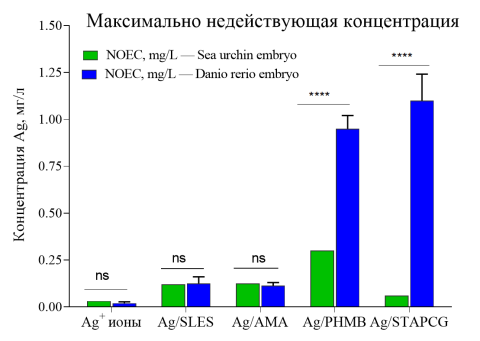
Engineering nanomaterials are widely used in various fields of human activity. Thus, silver-based nanoparticles are widely used in medicine, agriculture, and cosmetics. Modification of the surface of nanoparticles with various stabilizers is one of the most widely used methods for increasing their stability and expanding the possibilities of their practical application.
However, one of the key issues in the use of nanoparticles is the assessment of their potential danger to living beings and humans. Previously, we evaluated the toxicity of silver nanoparticles after application of various types of organic stabilizers on freshwater fish (Abramenko et al, 2019). As part of the ongoing research, a study was conducted on the stability and toxicity of silver nanoparticles to marine organisms. Sea urchin (Paracentrotus lividus) embryos were used as a test object. It was shown that silver nanoparticles modified with some organic compounds in sea water remained stable for a long time. At the same time, the toxicity of silver nanoparticles decreased with an increase in their tendency to agglomerate in sea water.
As a rule, silver ions were more toxic than silver nanoparticles. However, in some cases, the toxicity of organic stabilizers was comparable to that of silver ions. Thus, it was shown that the chemical nature of the stabilizer significantly affects the stability and biological effect of silver nanoparticle dispersions.
Sea urchin embryos were more sensitive to silver ions and nanoparticles. The research has shown the necessity of using different test objects for assessing the potential hazard of engineering nanomaterials and simultaneously assessing the toxicity of organic stabilizers that are part of the modified nanoparticles. The results of the work are published in the journal Nanomaterials (Q1 WOS, IF=5.719)
Abramenko N. (IEE RAS), Semenova M. (IBR RAS), Khina A. (MSU), Zherebin P. (MSU), Krutyakov Y. (MSU, NRC “Kurchatov Institute”), Krysanov E. (IEE RAS) ; Kustov, L. (MSU) The Toxicity of Coated Silver Nanoparticles and Their Stabilizers towards Paracentrotus lividus Sea Urchin Embryos. Nanomaterials - 2022. - Vol. 12. - 4003.
